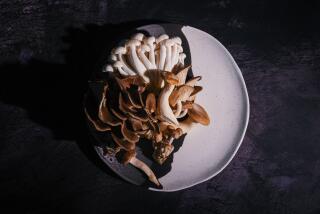Proper Asparagus
- Share via
It all started in a San Diego share-rental with a fern dangling from one of those 1970s macrame potholders. Classes were about to begin at UCSD, and I had an appointment to see an apartment. As I assessed the barefoot landlady, her fern kept tickling my neck.
“Wild asparagus,” she whispered. “Reminds me of dinners with Mom. Loved the asparagus, not Mom.” She nipped off a branch and munched distractedly. “Ever read Euell Gibbons?” I decided against taking the apartment and wouldn’t read Euell Gibbons’ 1962 book “Stalking the Wild Asparagus” until much later in life. And it was nearly 20 years before I encountered another wild asparagus. But this time, the circumstances were less sinister. I was hiking through pre-Roman ruins in Sardinia.
A winemaker was showing me his family’s Nuragus vineyards, stitched among rolling orchards north of Cagliari. Probably the oldest native Sardinian grape variety, Nuragus got its name from the island’s 7,000 Bronze Age cyclopean stone mounds called Nuraghi, many of which are edged by grapevines and wild asparagus.
The owner, Giuseppe Argiolas pinched the scaly head off an asparagus, indicating I should taste it. Hesitantly I sniffed and took a bite. I’ve been a wild asparagus addict ever since.
A wispy weed with grass-green stalks 5 feet long, Liliaceae Asparagus officinalis is the mother of all commercial varieties and, to my palate, more intensely flavorful than most varieties. It grows from a cluster of underground rhizomes that yield pencil-thin, edible spears for more than 30 years. My Sardinian encounter piqued more than curiosity: I began stalking books about asparagus in public libraries, snapping up the cultivated version in open markets and the wild ones wherever I found them growing. In parts of California, for instance, escapees from cultivation thrive among the coyote shrubs, to the delight of Euell Gibbons’ wild-food followers.
But it’s the Italians who’ve always been fanatical worshipers of the vegetable. There are numerous annual asparagus festivals around the country. The ancient Romans grew the vegetable to obscene sizes, dedicating it to Venus and ascribing it aphrodisiac qualities that have never been scientifically proved. I once trekked to Bassano del Grappa, a farm town inland from Venice, where I discovered that each newlywed couple indeed receives a single spear flanked by two boiled eggs.
The ancient Romans were also probably the first to recognize that asparagus should barely be cooked. Whenever Augustus Caesar felt rushed, it’s said, he ordered underlings to accomplish tasks in “less time than it takes to cook an asparagus.” Old Italian recipes haven’t changed much. One calls for parboiled or grilled spears to be dipped in olive oil and mixed with crumbled boiled eggs--a surprisingly exquisite combo. Lemon and olive oil with a pinch of freshly ground black pepper is a centuries-old favorite asparagus dip of Mediterranean nations. There etiquette says that when asparagus is correctly cooked al dente, one should be able to hold the spears by the base between thumb and forefinger and savor them like a banana. In Italy, slicing asparagus with a knife and fork is an insult, indicating the cook has rendered this gourmet treat flaccid. After all, few things are worse than limp asparagus, wild or cultivated.
Asparagi Con le Uova
(Asparagus with Crumbled Eggs)
Serves 4
4 large eggs
1 1/2 pounds green asparagus
1/4 cup extra-virgin olive oil
4 tablespoons freshly grated Parmigiano-Reggiano, plus 1/4 cup for garnish
Salt
Freshly ground black pepper
Put eggs in a small saucepan filled with cold water, bring water to a boil and simmer for 12 minutes. Pour off boiling water and run cold water over eggs until easy to handle. Peel, roughly chop and place in a medium-size mixing bowl. Set aside.
Bring 2 cups of water to a boil in a large pot or frying pan. Rinse asparagus and with a vegetable peeler or paring knife, scrape the stems and snap off the woody ends. Toss asparagus into boiling water, cover, and when the water returns to a boil, remove lid and cook until barely al dente, 5-8 minutes.
With a fork stir the oil, grated cheese and a generous pinch of salt and freshly ground black pepper into the chopped eggs, crushing to form a coarse paste. With a ladle, add 1-2 teaspoons of the asparagus boiling water, thinning the paste.
Drain asparagus through a colander, rinse with cold water and transfer to serving platter. Garnish with the chopped egg mixture and additional cheese if desired.
*
Food stylist: Christine Masterson
*
David Downie is the author of “Enchanted Liguria” (Rizzoli International) and the upcoming “Cooking the Roman Way” (HarperCollins).
More to Read
Eat your way across L.A.
Get our weekly Tasting Notes newsletter for reviews, news and more.
You may occasionally receive promotional content from the Los Angeles Times.










